|
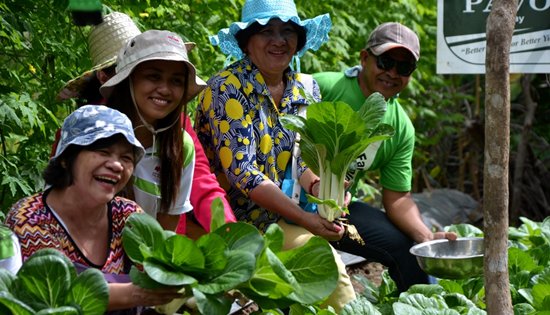
Officials
from DAR and East-West Seed Philippines harvest organically
grown pechay at the farm of Jose Dautil (right) in Barangay
Hinabay, Inopacan, Leyte. (Jose Alsmith L. Soria) |
Hello veggies,
goodbye abaca!
By JOSE ALSMITH L. SORIA
April 19, 2016
TACLOBAN CITY – When we
reached Barangay Hinabay, we were led to a vegetable farm of Jose
Dautil, 54, that was ready for harvest. We picked some kilos of sweet
pepper, and pechay, and paid him the corresponding price. Then we
moved to Barangay Cabulisan to see more vegetables in other farms.
These adjacent villages nestled on top of a mountain in Inopacan,
Leyte are now known for organic vegetables.
Farmers here are now
seriously pursuing high value organic vegetable production after the
Department of Agrarian Reform (DAR) subjected last year the members of
two agrarian reform beneficiary organizations (ARBOs) to a five-month
training on high value crops production using the natural farming
system.
Being covered by the second
phase of the Agrarian Reform Communities Project (ARCP-II), DAR tapped
the East-West Seed Philippines for the conduct of the said training
under the Agricultural Enterprise Development to the Hinabay Upland
Farmers Association (HUFA) and the Cabulisan Multi-Purpose Upland
Farmers Association (CAMUFA).
When asked what they like
about organic vegetable production, Marissa Bisnar, 38, an agrarian
reform beneficiary (ARB) said the products are sold at a higher price
than those grown the traditional way. Even if they are a little bit
expensive, more consumers prefer to buy organic vegetables, she added.
From her last harvest,
Marissa shared that she earned P8,350 from her four plots of sweet
pepper, four plots of tomato and ampalaya, which became additional
income for her family.
Cristita Abenoja, a merchant
from Barangay Cabulisan who buys the farmers’ harvests and sell them
at the town’s market disclosed that her products are easily sold out
because consumers opt for organic vegetables.
Organic farming now becomes
the trade mark of these two barangays. When buyers learn that the
vegetables come from the said barangays, they already know that it’s
organic, Abenoja said. Further, “my customers increased,” she added,
because the information had spread to nearby towns like Hindang, Bato
and Baybay City.
For that, these farmers
living on top of the mountain, 18 kilometers away from the town proper
are thankful they were taught organic farming.
Abaca used to be the major
crop of the farmers here. But because of the bunchy top disease,
farmers ceased planting abaca, and shifted to vegetable production in
2004. Last year, with the joint effort of DAR and East-West Seed
Philippines, the natural farming system was introduced and changed the
lifestyle of the farmers here.
With this method the farmers
no longer sniff chemicals when spraying pesticides, according to
CAMAFU president Edelito Merrano Sr., 51. Likewise, they can save more
because they no longer buy fertilizers and pesticides, he added.
Instead, they use the
vermicast their association is producing. Vermi-culture and vermi-composting
have been introduced to them by DAR in 2015 as alternative sources of
livelihood.
CAMUFA was among the 100 ARB
organizations provided with a shredder and 30 kilos of African night
crawlers last year.
At the moment CAMUFA is also
selling vermicast at P350 per sack of 50 kilos. While African night
crawlers are being sold by the association at P500 per kilo.
|
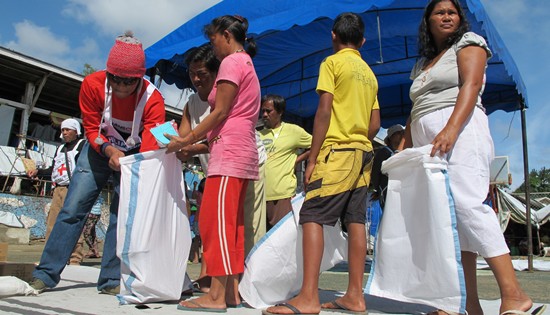
About
450 displaced families in Surigao del Sur each received food
supplies good for one month - consisting of 50 kilograms of
rice, 2 litres of oil, 2 litres of soy sauce, 1 kilogram of
salt, and 2 kilograms of sugar - as well as a hygiene kit
containing bath soap, shampoo, detergent, feminine hygiene
products, toothbrushes and toothpaste for a family of six.
(ICRC/L.Lagasca) |
Continued support
for people displaced by armed violence in Surigao del Sur
By ICRC
February 22, 2016
MANILA – Around 2,400
people displaced in Surigao del Sur received one-month food supplies
and hygiene items to help them cope with their displacement since
September 2015.
The International Committee
of the Red Cross (ICRC), with its primary partner the Philippine Red
Cross (PRC), distributed the relief items on February 18 to complement
the aid already given by the authorities.
"Prolonged displacement is a
challenge for both the affected families and the authorities. The
displaced depend on aid as they still fear going back home," said
Pascal Porchet, head of the ICRC delegation to the Philippines. "We
are here to fill in gaps and ensure that the families get adequate
support while they remain displaced."
The majority of the
displaced have been living in the provincial sports complex in Tandag
City for over five months now, after three civilians were killed in
their community.
"We have been here since
September 1, 2015, and we still fear for our safety," said Leonila
Enriquez of Brgy. Diatagon, Lianga municipality. "We are very grateful
to the ICRC for helping us since the early part of the displacement
until today," said the mother of eight children.
While the general health
situation in the sports complex is managed well by the Provincial
Health Office, cases of stomach problems and diarrhea were reported. A
probable cause is poor hygiene and sanitation in the evacuation
center.
Between September 2015 and
January 2016, the ICRC and the PRC already helped 3,500 displaced
persons in Surigao del Sur with food, household and medical items,
potable water supply, and construction of toilets in the evacuation
center.
The ICRC is a neutral,
impartial and independent humanitarian organization whose mandate is
to protect and assist people affected by armed conflict and other
situations of violence. It has had an established presence in the
Philippines for over 60 years and a permanent presence in Mindanao
since 1986.
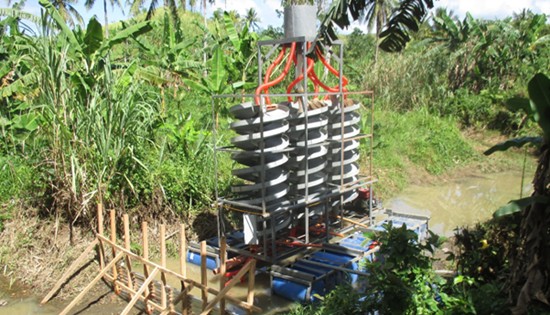
The
spiral machine used for panning in the gold exploration. |
Gandara officials
deny pay-off over the Cobarrubias’ “gold and silver exploratory work”
By GINA DEAN
February 18, 2016
CALBAYOG CITY – The
Sangguniang Bayan of Gandara finally revoked and nullified the
resolution granting Mrs. Cherry dela Cruz Cobarrubias to rehabilitate
Gandara River by means of dredging. Said resolution was approved in
2014 under the administration of Mayor Eufemio Oliva and Vice Mayor
Jonathan Isanan.
However, the municipal
government discovered that the dredging operations funded by the
Cobarrubias, has turned out to be an exploration work of gold and
silver mineral deposits at Brgy. Gerali. Local officials were
lambasted by concerned citizens over the social media and accused of
receiving pay-off from said permittee (or holder of exploration
permit).
In a public hearing held
last February 10 at Gandara Cultural Center, Mayor Oliva denied the
bribery issue imputed against them by the people. He clarified that
the resolution was approved by the sanggunian in good faith without
receiving any favour from Don Angelo C. Cobarrubias or his mother
Cherry. The approval of the application for exploration is not under
the municipal government but under the DENR-Mines and Geosciences
Bureau Regional Office 8 after the applicant has completed all the
necessary documents required by concerned government agency.
MGB-8 OIC Regional Director
Nonita Caguida explained that Don Angelo C. Cobarrubias’ application
for Mineral Production Sharing Agreement (MPSA) was filed on April
2005 covering 808 hectares of land located at Gandara and San Jorge,
Samar. In the process of application, a Notice of Posting was sent by
MGB-8 to the provincial government of Samar which was automatically
downloaded to the concerned municipalities for 30 days posting in
conspicuous places.
The purpose of posting was
to inform the public and concerned stakeholders for possible protests.
Receiving no complaint within the reglementary period prescribed by
law, the application of Cobarrubias proceeded smoothly with a
Certificate of Posting allegedly issued by each municipality.
But while in the process of
acquiring MPSA, Executive Order No. 79 or “Institutionalizing and
Implementing Reforms in the Philippine Mining Sector Providing
Policies and Guidelines to Ensure Environmental Protection and
Responsible in the Utilization of Mineral Resources” was issued in
June 2012. Pending the issuance of MPSA, the proponent amended their
application into exploration and submitted it to MGB-8 for final
validation and clearance.
Caguida clarified that all
the application documents of Cobarrubias were scrutinized; and in fact
the 808 hectares was reduced into 501 after the Department of
Environment and Natural Resources Office conducted study in the
covered areas.
For those who are under the
“No Gold Zone” areas (tourist and agricultural areas), it could not be
covered by the exploration work. Upon validation of application
documents, the exploration permit covering 501 hectares situated in
Gandara and San Jorge, Samar, was released by DENR’s Mines and
Geosciences Bureau Regional Office 8 on January 20, 2015 to Don Angelo
C. Cobarrubias of 2711 B-Wack-Wack, Twin Towers, Wack-wack,
Mandaluyong City.
Under the Mining Act of
1995, the exploration allowed the permittee to conduct exploration
work within a period of two years from its approval, and subject for
renewal on the same period up to 8 years for metallic and 6 years for
non-metallic. Based on research, gold is considered metallic mineral
while silver is a combination of different small elements which are
found in gold, lead, zinc and copper ores.
People Cry, No to Mining!
Out of 69 barangays of
Gandara, 41 have attended the public hearing with 924 registered
participants coming from the different organizations like the church,
business sector, senior citizens, youth, academe, government retirees,
concerned citizens, local PNP and municipal and barangay officials.
Citizens of said municipality were shouting as a sign of protest to
the exploration work being conducted by the Cobarrubias at Brgy.
Gerali since 2015.
The church under the Diocese
of Calbayog cited the 50 year moratorium of mining operation issued by
the government after the Bagacay Mines experience. Brgy. Gerali
according to the Municipal Agrarian Reform Officer, Aida Gamba is an
agrarian reform community along with other nearby villages.
In the absence of a map,
Samar PENRO Elpidio Simon believed that the 501 hectares which was
claimed by Cherry dela Cruz Cobarrubiasas a mining zone area is under
Samar Island Natural Park. He added that the DENR have implemented the
National Greening Program (NGP) and Community-Based Forest Management
Program (CBMP) at Brgy. Gerali and nearby villages.
Who is Cherry dela Cruz
Cobarrubias?
She claimed herself as a
true-blooded Gandareño who hailed from Brgy. Gerali. Established
connections in the circle and sponsored the rehabilitation of Gandara
River. Received an award from the municipal government as the “Most
Outstanding Gandareño in 2014”. In a conversation with a reliable
source, he disclosed that Cherry dela Cruz Cobarrubias’ mother was
from Matuguinao and her father was from Catbalogan, Samar. Contrary to
her claim that her family originated from Brgy. Gerali where
exploratory work is being conducted, the source revealed that Cherry’s
father used to teach at said barangay.
She had a colourful life in
the film industry as she produced “Bulaklak ng City Jail” and many
more. In the field of politics, she is still the president of Marcos
Loyalists Movement.
According to the source,
Gerali mineral deposits was then a long time project of Cobarrubias.
She was able to persuade millions of investment from an Australian
couple but their partnership was terminated when the couple has
detected suspicion from said operation. It was also learned that
Samar’s former Vice Governor Jesus Redaja made an investment in a
mining operation at Bagacay Mines, but the deal was cut short leaving
the latter’s equipment abandoned at the mining site.
To get Cherry Cobarrubias’
comments, the writer requested her geologist for an interview but no
feedback was received.
The National Law vs. People
Power
Despite the strong
disapproval of the people of Gandara, Cherry Cobarrubias is confident
that the exploratory work will pursue.
MGB-8 OIC Regional Director
NonitaCaguidasaid that the documents for the acquisition of
exploratory permit have undergone a long scrutiny, and local
ordinances or resolutions with the intention of revoking such permit
cannot be allowed for it cannot supersede the national law as provided
in RA 7942 or the Philippine Mining Act of 1995. Caguida was one of
the witnesses in the Exploration Permit issued by MGB-8 to the
Cobarrubias in January 20, 2015.
On the other hand, an
insider of the Environment of Natural Resources Office advised that a
written petition of the people may work by directly submitting the
same to the central office. The absence of a public consultation prior
to the exploration work could be one of the basis of the petition, he
said.
New Greenpeace
report estimates coal plant emissions could kill 2,400 Filipinos per
year
By
GREENPEACE
February 3, 2016
MANILA – While coal
is king in the Philippines, a new Greenpeace Southeast Asia report has
revealed for the first time the current health impacts of existing
coal-fired power plants, as well as projected health impacts of
operating and planned power plants in the Philippines.
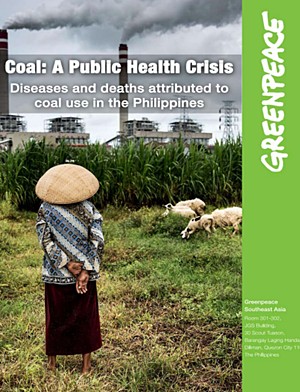 The report, Coal: A Public
Health Crisis. Diseases and deaths attributed to coal use in the
Philippines showed an estimated 960 premature deaths each year due to
stroke, ischemic heart disease, other cardiovascular diseases, and
respiratory diseases. If the new power plants are to be developed,
premature deaths may rise up to 2,410 – more than double the current
number of people dying from coal-related pollution in the Philippines.
The report, Coal: A Public
Health Crisis. Diseases and deaths attributed to coal use in the
Philippines showed an estimated 960 premature deaths each year due to
stroke, ischemic heart disease, other cardiovascular diseases, and
respiratory diseases. If the new power plants are to be developed,
premature deaths may rise up to 2,410 – more than double the current
number of people dying from coal-related pollution in the Philippines.
“Results of the research
show that coal-fired power plants expose everyone in the Philippines
to toxic pollution, resulting in hundreds of premature deaths every
year,” said Lauri Myllyvirta, Senior Global Coal Campaigner at
Greenpeace International and also one of the authors of the research.
“Leading economies from the United States to China and Europe are
already relaying on modern, renewable energy sources for their
additional power needs, showing that this is a real option for
Philippines as well.”
More than one-third of the
energy used to generate electricity in the Philippines comes from
burning coal. Currently, the country has 17 operational coal plants,
with 29 more approved by the Department of Energy (DOE), set to begin
commercial operations by 2020.
The report is based on
research carried out at Harvard University on the impacts of emissions
coming from coal-fired power plants on the air quality of selected
countries in Asia. For the Philippine version, Greenpeace collaborated
with HealthJustice to write the report, with support from Health Care
Without Harm – Asia and the Philippine Movement for Climate Justice.
Coal use harms the
environment and public health at every stage of its life cycle.
Coal-fired power plants emit sulfur dioxide (SO2), nitrogen oxide
(NO2) and other gaseous pollutants in the air that can react
chemically to form particulate matter that is 2.5 µm in diameter.
Aside from generating
particulate matter, coal combustion also affects health indirectly by
contributing to greenhouse gas emissions. Climate change can bring
extreme heat, lead to natural disasters, and eventually increase
diseases transmitted through insects such as malaria and dengue.
The study evaluated 13
operational coal-fired power plants in the Philippines with a combined
installed capacity of 3,799.10 megawatts (MW), as well as the
potential impacts of plans to build 29 new coal-fired power plants
with a total capacity of 11,700MW, which could dramatically increase
levels of sulfur dioxide (SO2), nitrogen oxide (NOx) and PM2.5
emissions.
“This pioneering study is an
important addition to the growing body of health and scientific
research on the adverse impacts of coal-fired power plants, not only
to the environment, but to human health as well,” said Reuben Andrew
Muni, Climate and Energy Campaigner for Greenpeace Philippines. “We
strongly recommend for the DOE, the DOH and other policy-makers to
read it and take heed as it presents a strong case on why the
Philippines should end its dependence on coal-generated electricity
now, not only for economic, environmental and climate change reasons,
but on public health grounds as well.”
“This new study just
confirms what we already know about the health effects of coal based
on international evidence. For the longest time, we have been ignoring
the environmental case for the phase out of coal. I hope that this
time, the public health argument will convince us that coal is not the
way to go towards a clean, sustainable and healthy energy future,”
said Dr. Renzo Guinto, Campaigner for the Healthy Energy Initiative,
Health Care Without Harm-Asia.
“New coal plants are a
lose-lose proposition for the public. Increasing dependence on coal
will consign us to dirty air for 30 or more years, as coal gets more
expensive and other countries abandon it as an energy source. There is
a way out of this vicious cycle. We must embrace renewables through a
strong, health-driven energy policy," said Atty. Ipat Luna, a Trustee
of HealthJustice-Philippines.
“Coal burning is a proven
nuisance to health and the climate. The more coal plants and mines are
commissioned by the government, the more people and communities are
placed in the direct path of perdition. Undoubtedly, it is a kiss of
death to host communities and vulnerable nations like the Philippines.
We thus demand for a moratorium on new coal plants, phase out of
existing ones, and for a just transition to renewable energy options”
said Atty. Aaron Pedrosa, SANLAKAS Secretary General and PMCJ Energy
Working Group Head.
Considering the Philippines’
rising population, poor health outcomes, and the scarcity of resources
needed to adapt to the worst effects of climate change, Greenpeace
recommends that the country should end its heavy dependence on coal as
an energy source and accelerate initiatives involving renewable energy
(RE) resources to meet its energy demands. RE is emerging as the
energy of choice for an increasing number of communities and local
government units (LGU). The report recommends that the government
phases out of coal and fully embrace RE sources in the Philippines
based on public health considerations.
Download the pdf version of
Coal: A Public Health Crisis. Diseases and deaths attributed to coal
use in the Philippines at
http://www.greenpeace.org/seasia/ph/press/reports/Coal-A-Public-Health-Crisis/
“Sole for a Soul
Project”: PAREF Rosehill goes to the peripheries
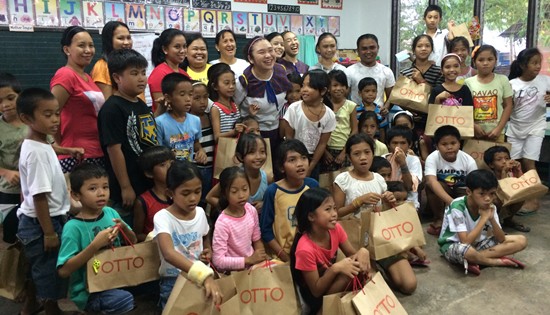
By GLECY GAMBOA, PAREF
Rosehill School
January 20, 2016
ANTIPOLO CITY – “The
project helped me learn to fully go out of my comfort zone and open my
eyes to the needs of others, and knowing this has helped me further
understand and give meaning to our school's mantra, "I lead. I serve."
Betina Sales, PAREF Rosehill
Student Council President, together with officers, Mika and Gabrie
Cordero and teachers, Ms. Calai Clarino and Ms. Carmel Mendoza,
represented the Rosehill students who donated black school shoes to
196 students of Doña Brigida Elementary School in Tolosa, Leyte on
December 14, 2015.
Betina, Mika and Gabrie were
very happy and fulfilled when they saw the smiles on the faces of the
students as they received their early Christmas gifts. As Mika said,
“I felt really glad because we were able to share our blessings and
time with the kids.”
Each pair of shoes was
personally labelled and inside each shoe box was a letter from a
Rosehill student. One of them, Angela, wrote: “Hope you like the
shoes! Study hard to reach your dreams and never give up. Stay strong
with any problems you will encounter and take care. God bless you
always. Never forget to smile, Larabel.”
To heed Pope Francis’ call
to go to the peripheries, the PAREF Rosehill Student Council launched
its outreach project, “Sole for a Soul” in August 2015. This is one of
the school’s on-going relief efforts for Tolosa, Leyte residents who
were severely affected by Typhoon Yolanda last November 2013.
The Student Council believes
that giving a pair of school shoes to the beneficiaries will help them
feel better about going to school.
Rosehill is grateful to
parents, students and teachers who supported this project and to the
Tindog Tolosa Foundation for this opportunity to reach out to Doña
Brigida students and teachers.
Students from Grade 6 to
Fourth Year High School donated P500 and they were encouraged to raise
the money on their own.
Niki, a Grade 7 student
said, “I saved up from my allowance and I was happy that I got to help
someone who deserves much more.”
Bea, who is in Grade 6,
earned her P500 donation by playing the violin in an event. “I felt
great to be able to help in my own little way,” she said.
Indeed, it was worthwhile
saving up for that ‘soleful’ cause. As Betina said, “Seeing the smiles
on their faces and even some tears of joy upon getting the shoes
really made me realize that the best things in life are free. In the
end, it was as if the 500 pesos we each raised had a new "value" and
it was, ironically, priceless.
Improved living
conditions for inmates affected by Leyte prison fire
By ICRC
December 2, 2015
MANILA – Access to
clean water, sanitation and overall health and living conditions have
improved for 1,800 inmates affected by the fire that struck Leyte
Regional Prison two months ago.
On October 8, the prison’s
Maximum Security Compound was completely destroyed by a fire that also
claimed the lives of 10 inmates and injured several others.
“Since it would take some
time before a permanent structure could be rebuilt, we supported the
prison authorities in taking temporary measures so the inmates may
have slightly better conditions,” said Woody Assaf, head of the
International Committee of the Red Cross (ICRC) office in Tacloban.
On October 25, the ICRC
installed two rub halls or relocatable tent-like structures as
emergency shelters. The affected prisoners were initially moved to the
Minimum Security Compound or slept outdoors after the blaze.
“We continue to improve the
rub halls by working on its concrete flooring. Elderly prisoners and
those with ailments were prioritized to occupy the rub halls, which
also helped decongest the Minimum Security Compound, where about 750
affected prisoners remain. The authorities could partly restore the
segregation between compounds, which helps in prison management,” said
Assaf.
Two 10,000-liter water
tanks, distribution lines, and water points were installed by the ICRC
to increase the availability of potable water in the prison,
benefiting all inmates. Twenty-four new toilets are also being built
for their use.
Relief assistance for the
prisoners, in the form of dressing kits, medicines and medical items,
2,000 hygiene kits, and 409 sleeping mats and blankets, were provided
by the ICRC about a month ago, on top of other emergency items it
distributed with the Philippine Red Cross a day after the fire.
Support was provided to ensure that access to basic health services
was maintained.
Within its confidential
dialogue with the Bureau of Corrections, the ICRC shared its findings,
coordinated its response plan, and will further support the
authorities in January to develop a plan of action to restore optimum
conditions of detention.
As part of its long-term
support to the detaining authorities, the ICRC will soon complete the
construction of a new infirmary in Leyte Regional Prison to enhance
access to, and improve the quality of, medical care for the inmates.
Leyte Regional Prison is one
of the places of detention being visited in the country by the ICRC, a
neutral, impartial, and independent humanitarian organization, to
monitor the conditions of detention and the treatment of people
deprived of freedom.
◄◄home
I
next►►